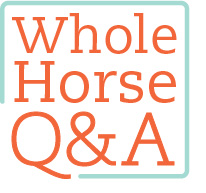Q My 20-year-old Appaloosa developed aspiration pneumonia about 12 years ago. She was on antibiotics for six weeks and since then had been doing great, except over the past five or six years she started developing heaves. We soak her hay and give her allergy shots. Why is it that when some horses with heaves cough, they also pass gas, at times explosively? I was told that’s not good. The hay soaking helps, but in Pennsylvania it’s tough when the water freezes. Would a hay steamer help kill dust, mold spores, or whatever is in hay to make my mare cough?

TERRI SHIFLETT, Pennsylvania
A Recurrent airway obstruction (RAO), commonly known as heaves, is a noninfectious breathing disorder usually affecting horses over age 7. It’s characterized by an increase in respiratory rate and/or effort at rest, as well as coughing, nasal discharge, and exercise intolerance. An examination of the lungs of a horse with RAO typically finds excessive mucus production and accumulation, inflammatory cells, and constriction of small airways.
Heaves is considered a hypersensitivity to inhaled organic dusts and molds contained in feed, hay, straw, and other bedding materials, so it’s good you’re concerned about your mare’s hay. Although exposure to allergens is considered vital to RAO development, the role of a viral or bacterial infection leading to susceptibility remains speculated but unproven.
Excess gastrointestinal gas production isn’t a common sequelae (abnormal condition resulting from a previous disease) to heaves. Though horses have a monogastric digestive system (a simple, single-chambered stomach, similar to ours), they also have a component of fermentation that occurs in the back half of their GI tract (cecum and large colon). It’s here that a significant amount of gas is produced while the feedstuffs are fermented, resulting in a fair bit of flatulence (see box).

Hay steamers fall into the category of environmental management of RAO. The purpose of a hay steamer is to heat the hay to temperatures greater than 212 degrees Fahrenheit to kill mold spores, mites, and bacteria, some of the allergens that can stimulate the clinical signs seen with horses suffering from heaves. The steaming process should eliminate the need to wet the hay—handy where winter temperatures drop below freezing. Anecdotally, steamed hay does seem to be helpful for horses prone to heaves, especially those in freezing climates.
There are multiple commercially made hay-steaming options available, from those that’ll steam one flake of hay at a time to models that can handle an entire bale. The commercially available models are minimally labor-intensive, requiring you only to add hay and water, then turn the unit on.
MELISSA ESSER, DVM, MS, DACVIM
Assistant Professor
Michigan State University






